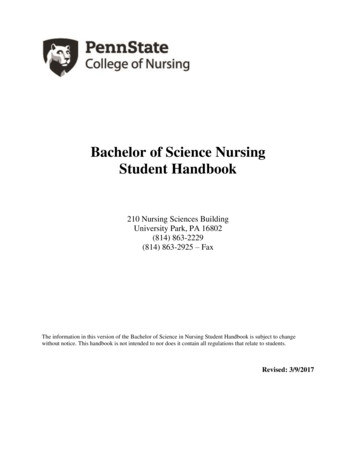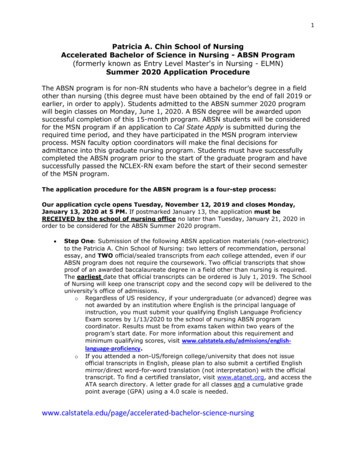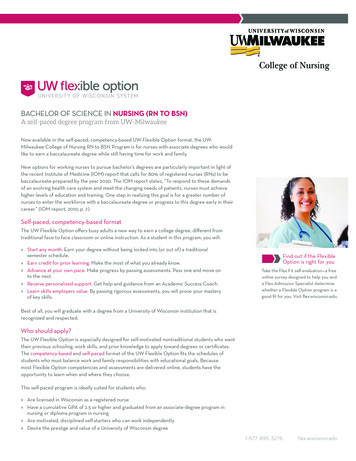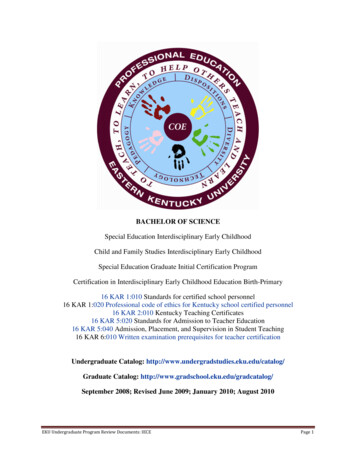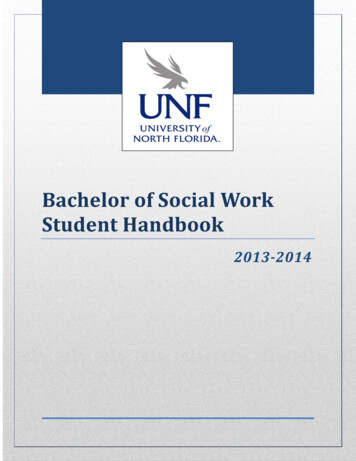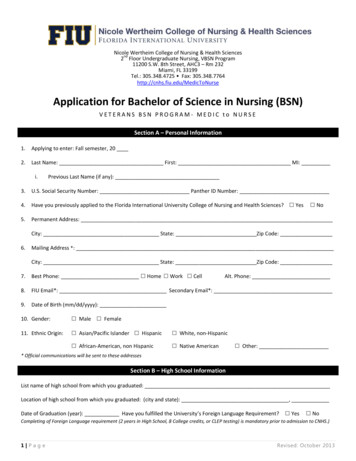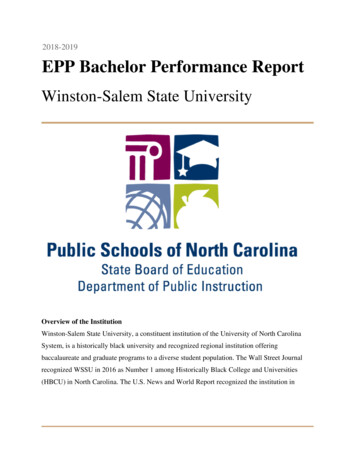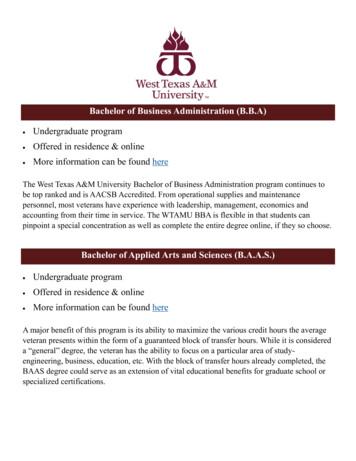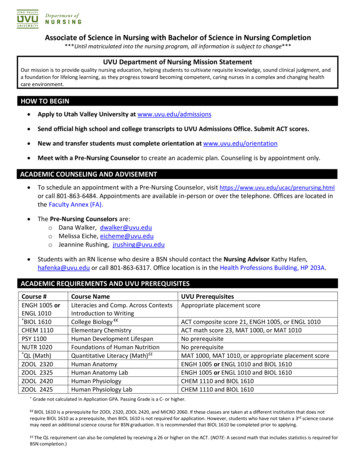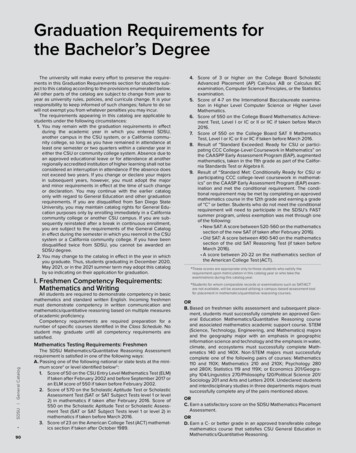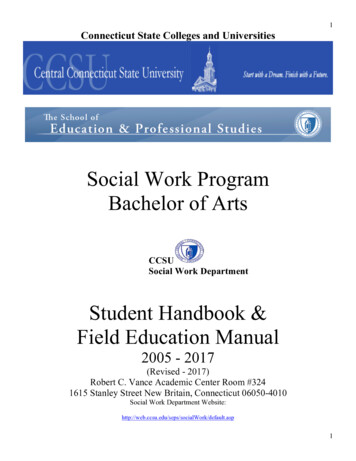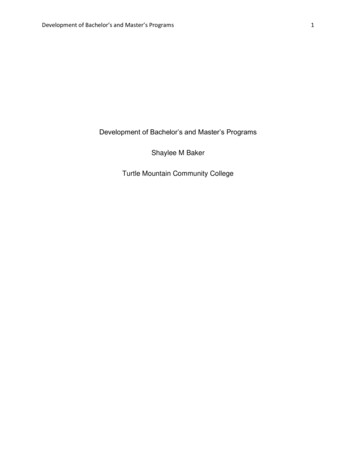
Transcription
Development of Bachelor’s and Master’s ProgramsDevelopment of Bachelor’s and Master’s ProgramsShaylee M BakerTurtle Mountain Community College1
Development of Bachelor’s and Master’s ProgramsI.Introduction to EducationA. History of Tribal EducationB. Establishment of Tribal CollegesII.Native American CollegesA. The Founding of Tribal CollegesB. An Overview of Tribal CollegesIII.Indigenous Leadership in Higher EducationIV.A Look at Our GraduatesV.Aspects to ConsiderA. Types of Degrees Needed in the CommunityB. Increase of TuitionC. Hiring Qualified ProfessorsD. Expansion PlanVI.Recruitment of StudentsVII.Conclusion2
Development of Bachelor’s and Master’s Programs3AbstractIn the beginning, children educated themselves through observation andexploration. Native Americans lived as fishermen/hunters. Children did not go toschools, unless it was a private school. That is where education primarily began. Soonafter private schools, boarding schools came into play. Soon after, the education systemdeveloped, more public schools came into play and more universities started developfor higher education. The Navajo, then built the first tribal college in 1968. Today thereare 39 tribal colleges in the United States. Turtle Mountain Community College began in1972, and the development of the Turtle Mountain Community College has increasedsince. Currently the college has one Bachelor’s program. That is in the TeacherEducation Department. Turtle Mountain Community College should make thedevelopment of Bachelor and Master degrees it’s highest priority in the next 10 years.Tribal colleges offer something no other college has to offer. We offer the teaching ofour culture. Tribal colleges provide equal opportunity amongst all students and theyhave a strong sense of communication amongst the students that attend. With manyaspects to consider, there is one big picture to think about. That is, providing equalopportunity for our younger generation to have option to earn their degrees at home.
Development of Bachelor’s and Master’s Programs4When did education begin? How has it developed over the years? Education issimple, yet complex. Education began with the simplicity of a child’s observation. Achild’s observation was the only form of education. After many years had passed, theeducation system became a little complex. Public schools, private schools, and highereducation institutions began to develop. However, tribal colleges began to develop aswell. Today most tribal institutions only offer a two-year degree, with only a few thathave Bachelor’s and Master’s degrees available. Over the course of this paper, you willfind arguments for the development of more Bachelor’s and Master’s degrees.Education began with a child’s observation. In the early ages, Jews were themost insistent that children would be educated. Whereas in Ancient Greece, Sparta wasto develop soldiers. In Athens, the idea was to develop citizens trained in peace andwar. Throughout the years, education began to blossom and develop. Boys attendedgrade school from ages 6-14. As we look at famous educators, such as Plato, whotaught geometry, astronomy, harmonics, and arithmetic. Socrates primarily taughtoratory and rhetoric. “The most highly educated women were the hetaerae, orcourtesans, who attended special schools where they learned to be interestingcompanions for the men who could afford to maintain them” (Guisepi, 2017). As theeducation system developed, public schools, private schools, and tribal colleges cameinto the American society.The establishment of tribal colleges began in the 1960’s. The Navajo (Dine)Community College was the first to be chartered in 1968. After the Navajo College wasestablished, other tribally controlled community colleges began to develop throughoutthe Great Plains. The Turtle Mountain Community College (TMCC) was chartered in
Development of Bachelor’s and Master’s Programs51972. Also in 1972, The American Indian Education Higher Education Consortium(AIHEC) was formed, which is an informal collaboration among member colleges.August Breuninger proposed the creation that an Indian University should focuson Native American culture. With Indian Universities, culture should definitely be afocus. As Native Americans, we want to keep our cultures alive. August Breuningerstated:A University for Indians is the greatest step that we educated Indianscould make in uniting our people It would eliminate the generalconception-that an Indian consists of only feathers and paint. It wouldsingle us out-as REALLY PROGRESSIVE INDIANS. It would give us abetter influence with the rising generation, by setting out our character insuch a conspicuous manner as to be observed and imitated by them(Boyer, 1997).The importance and value for higher education is clear to Native American Indianleaders. A college degree could be used to strengthen reservations in today’s era. “Thisbelief that higher education could serve the practical needs of a tribe was the secondingredient necessary for the founding of the tribal college” (Boyer, 1997). AlthoughNative American struggle to complete their education, it would be beneficial for ourNative American students to have the opportunity to receive a higher level degree in aprogram of their choice.It was clear to Native American educators that Native American students werefaced with two barriers. The first barrier is the struggle of getting into a college. The
Development of Bachelor’s and Master’s Programs6second was of course, completing college and earning a degree in higher education.The Meriam Report and the Higher Education Act encouraged Native Americanstudents to enroll in universities and colleges. In the Meriam Report, it talked about thefundamental needs for education. It stated that the most fundamental need in Indianeducation is a change in a point of view. What does this mean exactly? Well, educationfor the Indian in the past meant the Indian child was to be moved as far away fromhome as possible. The Indian child had to adopt to an American way of life. Whereastoday, we must be culturally competent and culturally responsive to the students in ourclassrooms. At the college, it is our mission to incorporate culture into our curriculum.Tribally controlled community colleges are organized and are all funded in similarways with the federal government support. Some tribally controlled colleges in the stateof North Dakota are, the Turtle Mountain Community College, Fort Berthold CommunityCollege, Little Hoop Community College, Sitting Bull College, and the United TribesTechnical College. It has been said that the “tribal college is the most stable andpolitically independent institution” (Boyer, 1997). With that statement, I believe TMCCupholds this because of the resources and classes they provide. With the developmentof more programs and resources, TMCC could pride itself on being one of the moststable and politically independent institutions.The curriculum for tribal colleges varies from each institution. Most tribal collegesstarted out as two-year institutions. The goal was to provide graduates with theavailability of jobs. The most common degrees that tribal colleges can pursue aredegrees in business, health, associate degrees and early childhood education. Nowtribal colleges want to develop more than just two year degrees. More and more tribal
Development of Bachelor’s and Master’s Programs7colleges are developing four year degrees and even graduate degrees. Oglala LakotaCollege started out as only offering two-year degrees. Now the Oglala Lakota Collegecurrently offers a master’s program in tribal management. The Turtle MountainCommunity College currently only offers a Bachelor’s degree in education.When considering developing bachelor’s and master’s programs, these tribalcolleges must consider one important aspect, which is funding. According to the book,Native American Colleges, the available funds are distributed to every Indian studentenrolled; no money is distributed for non-Indian students. Dr. Delorme stated, TurtleMountain Community College prides itself on being one of the cost-effective institutions.Dr. Terri-Marin Parisien had a similar answer to Dr. Delorme. She stated that we prideourselves with being super cost effective and we have the lowest tuition in the state.However, with the consideration of more Bachelor and Master degrees, tuition mayincrease.There is said to be an increase in Indigenous student leadership development.Leadership development surrounds Native leadership perspectives, effectiveness, anddevelopment. At tribal colleges many of them strive to embody wisdom, courage,strength, generosity, vision with possibility, respect and humility with confidence. At thelocal tribal college, which is TMCC, we have a mission statement that we tend to live by.The staff, faculty, and students uphold the mission statement provided by the college.When thinking about developing more Bachelor’s and Master’s degree programs atTMCC, we must consider the fact that those who do graduate from here, will more thanlikely give back to the community by applying for a local job nearby. Students at thecollege all want to give back to their communities in more ways than one. Whether that
Development of Bachelor’s and Master’s Programs8be teaching the youth, providing computer support services, working diligently withothers and learning from the elders. More programs at the college can offer jobscommunity wide. In the community, we have several elders working. They are close toretiring, which means more jobs will be available to those who are qualified in that area.Dr. Teresa Delorme, received Educator of the Year in 1981. In 1989, she was theprincipal at the Turtle Mountain Elementary School. Delorme is now currently thedirector of the Teacher Education Department. She excelled at the college among othergraduates as well. Ken Sayers, enrolled into Turtle Mountain Community College from1977-1979. Stella Davis, earned her Associates of Arts degree at TMCC in 1978. All ofthe previous graduates from the college have gone on to excel doing wonderful things.Many of them stated that the college has provided them with a profound knowledge ofhigher education. With just the statement of the college providing them with a profoundknowledge of higher education, we know the college has the capability of succeeding inthe development of Bachelor and Master degrees. Can you imagine how the collegewould excel? The college could provide so many great opportunities for the students onthe Turtle Mountain reservation.When questioning and speaking to students around the college, many of them agreeabout the thought that the Turtle Mountain Community College should have thedevelopment of more Master’s and Bachelor’s degree programs. It would be veryeffective for those students who cannot afford to attend a university away from home,and it would provide an equal opportunity for students to earn a Bachelor’s Degree oftheir choice. Currently, the college offers one Bachelor’s Degree, and that is ineducation. Not every student, wants to pursue a career in education. When having the
Development of Bachelor’s and Master’s Programs9opportunity for more Bachelor’s and Master’s programs, it gives students an option topursue their career of their choice.One important aspect to consider is what types of Bachelor and Master Degrees areneeded in the community. According to Dr. Terri Martin Parisien (2017), they did asurvey and at the time of the survey, the focus was on education. If she were to developa program, she said it would be for public health. As a small Native Americancommunity, we face a lot of health issues that need to be addressed. These healthissues need some sort of action immediately. Another area for a Bachelor’s programwould be one in our Native Language. Parisien stated “If we don’t have some kind offormalized plan for our language in terms of how we are going to present that we needto keep it going for our community” (Parisien, 2017). Language is an important part ofour culture and heritage. Our language is slowly diminishing. With a Bachelor’s degreein our own Native Language, can set up so many opportunities for the members of ourcommunity. This Native Language program can be highly successful in so many ways.It would not only attract the younger generation, but it would attract the adults who havelost the practicing of their language and culture along the way.Dr. Teresa Delorme stated that right now were are really needing teachers. Shereceived a call previously in the year from the high school principal asking if we have amath or English/Language Arts program, because they are in a serious need of math,science, and language arts instructors at the high school. According to Delorme, shestated “we need more members of our community earning their Masters” (2017). Mainlybecause we need to take a look at the fact that bachelor’s degrees are becoming arequirement at just an entry level job.
Development of Bachelor’s and Master’s Programs10Another aspect to consider is the fact that the college may need an increase oftuition, which could technically be a downfall of developing Master’s and Bachelor’sprograms. Parisien specifically stated that “the quality of education you receive for thatrate (low tuition) is one of the benefits for attending Turtle Mountain CommunityCollege” (Parisien, 2017). She has stated that there may be a slight increase in thetuition within the next few years. Currently we have Title III funding, and what Title IIIfunding does is that it helps develop new programs. With Title III funding, the collegetechnically has the right sources to develop new programs. Why not use our resourcesand make the college better? Make the community better? We have members in ourcommunity with a Bachelor’s degree that are qualified to teach new programs here atthe college.Another aspect to consider is the fact that we need to hire qualified professionals toteach the courses required at the bachelors and master’s levels. To be qualified toteach at the Master’s level, you must have a Master’s degree in the content you areteaching. We have local people around the community that are qualified to teach at theMaster’s level, but the only problem is that we do not have the funding to pay theseinstructors. With new programs and new instructors, we need to think about theavailable space for these classrooms.As one can see, there are several aspects to consider when thinking aboutdeveloping Bachelor’s and Master’s programs here at Turtle Mountain CommunityCollege. As a tribally controlled institution, looking into developing higher levelprograms, we must consider the need for an expansion plan. Of course, an expansionplan would be very costly, and the college does not have the appropriate funding to
Development of Bachelor’s and Master’s Programs11develop an expansion plan. Parisien explained to me that the college has a “Masters ofFacility Plan.” She stated that they are looking into developing a building for the CTEstudents. By creating a separate building for the CTE students, it would open up thewhole south side of campus. This would mean that there would be extra classroomsopen for new programs. Another thing that Parisien said was developing a daycareprogram for students who have children. With this daycare program, it would providestudents in the teacher education program to earn the practicum hours needed. Maybenot so much for the elementary education, but it could help in the early childhoodeducation program. Parisien stated” We do have enough space. As we look at buildingMaster’s degrees, we are looking at a partnership with the University of North Dakota(UND) and it would be in leadership” (Parisien, 2017). With a partnership through UND,it brings opportunities to those looking for a higher degree in leadership. Students canearn their degrees right from their hometowns without worrying about paying thousandsof dollars. With a partnership through UND, means the recruitment of new studentsaround the community and around the state.When speaking to both Dr. Terri Martin Parisien and Dr. Teresa Delorme about howwe could recruit students to coming to the Turtle Mountain College, a few contradictorythings came about. The first contradiction was the out of state tuition and internationaltuition. Beings that we live so close to the Canadian border, we should try and recruitstudents to come to school here. We do have Canadians that came over here into theUnited States, why can’t they go to school as well? But the contradiction with that isfinding a source of housing for these students. Over the course of a few years, thecollege conducted a survey, and from this survey they conveyed that most students
Development of Bachelor’s and Master’s Programs12typically tend to live with their parents. For those students that do not live with theirparents, had children of their own and already had their own places. “We had a coupleof instances where students did not have a place to live” stated Dr. Terri MartinParisien. When these instances came up, the faculty worked really hard to find out whatwas available and attempted to advocate for them to live in the apartments near thecollege.Dr. Delorme stated several of the same facts as Dr. Terri Martin Parisien did. Butshe added that she heard the apartments near the college are nearly full to completelyfull. She stated that it is very hard to find a source of housing around the community.During her first year here, she had to live with her sister. She drove around looking forplaces to live on her own, but did not find much for space. The other half of recruitingstudents, in this particular program (Teacher Education) is that she would not knowwhat to do if they received too many more students applying for the teacher educationprogram. “It would be wonderful to have 20 students enrolled and that they are all goingto be admitted” (Delorme, 2017). The problem with having 20 students enrolled in theteacher education program is that there are only two teachers teaching all the contentareas. The problem is not the number of bodies in the classroom, the problem isassessing all these students. From my understanding, and current knowledge ofeducational assessment, you need to consider the different learning styles of all thesestudents. With different learning styles, you need to find different forms of assessmentfor each student.The goal for tribal colleges is to rebuild cultures. Most cultures are diminishing. Tobe successful, tribal colleges have obstacles they need to overcome. Tribal colleges
Development of Bachelor’s and Master’s Programs13serve students, and strengthen communities. Not only do they do that, but they rebuildcultures. Attending a tribally controlled college means that it is a small, yet strongcommunity. In a small and strong community, staff and faculty tend to have more time tosupport students. Whereas, when attending a university, you are in a class of 50 students, and the only time you really see the professor is during the lecture. This couldbe a problem when you need one on one help when searching for support from yourinstructors. This would be another reason as to why Turtle Mountain CommunityCollege should develop more Bachelor’s and Master’s programs. “The reality is thatmost students struggle to make ends meet. The typical student has little savings andcannot rely on family members for aid” (Boyer, 1997). When attending a university, youare paying thousands of dollars for just one semester. The Turtle Mountain CommunityCollege has the lowest tuition in the state. With low tuition, students can save moneywhile earning their degrees.The fact that students have little in their savings, and they struggle to make endsmeet, it would be a great essence for students to earn their degree in their localhometown. This would help students save money
local tribal college, which is TMCC, we have a mission statement that we tend to live by. The staff, faculty, and students uphold the mission statement provided by the college. When thinking about developing more Bachelor’s and Master’s degree programs at TMCC, we must consider the
